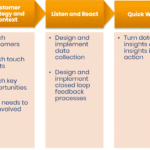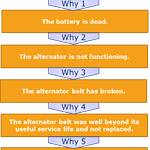I’m sure you’ve heard of Bill Clinton’s famous, but unofficial, 1992 campaign slogan: “It’s the economy stupid”. His chief of staff wanted to focus everyone on what was most important in the run up to the election.
That was a great approach but today I’m championing an anti-version of that slogan:
Get the Business Leader's Guide to Net Promoter Score Download HereThe reason is that recently I’ve had several conversations with senior managers of small, and not so small, businesses, which are looking to implement Net Promoter.
Great idea, until they tell me it’s with the specific purpose of tracking the performance of their staff.
Typically these businesses have grown to the point where senior managers are not able to be everywhere at once. They worry about company reputation as they grow increasingly disconnected from the day to day interactions with customers.
This increasing distance is not bad per se, there are only some many individual customers the CEO of a major bank can meet in person. What is bad is trying to insert a metric (any metric) into to the process with the idea that it will keep everyone in line.
True, on the surface it seems quite rational; run a transaction survey, associate the relevant (sales, support, etc.) staff with the response and then report on the individual’s score. Use the score to hand out bouquets or brickbats at the end of the quarter or year. We do it with sales, why not Net Promoter Score?
Because it’s not the same. Sales are an absolute number. Net Promoter is not because it is assessed subjectively by people and surveying, so it it subject to a range of sample size caveats.
Net Promoter is a great tool but great tools can be used to cause great harm when applied in the wrong way. Just ask Alfred Nobel about the invention of Dynamite.
Here Are the Problems With A Simplistic, By The Numbers Approach
Score begging
The problem with focusing the entire organisation on just the score then doubling down by including it in the bonus system is that it drives the wrong behaviours.
You might think that providing a front line sales employee with a bonus for a high personal NPS make them focus on improving their score.
And it does. So, what is the easiest way to improve the score – just ask the customer to rate them highly when they receive the survey. It’s called score begging. Simple and worthless to the business.
If you doubt this happens just listen the next time you pick your car up after a service. In many cases you will be asked directly or indirectly to give the service a “9 or 10” in the survey. Or, the next time you stay in a hotel, check out the variety of ways they beg for scores.
Not only do these tactics make customers feel uncomfortable but you lose all value in the information you are receiving.
Is that 10 a “real” 10 or a “10 that should have been a 7”. Now all of your data is tainted.
The Focus Should be on Improvement
Improving your score by asking the customer for a better number, does not drive ongoing improvement in the business. By taking the shortcut you have lost your ability to understand how to make change and drive improvement in the business
Systems Drive Most of Your Score Not Staff
With very few exceptions, your business systems, not individual staff, drive the majority of the customer experience in a business.
Most staff are looking to do the right thing by the company and its customers. If they are unable to deliver an excellent service it is not normally because they are unwilling but because they are unable due to company systems.
Put another way, focusing on motivating staff to somehow do their job better drives much less improvement in Net Promoter, or customer satisfaction or Customer Effort score, or whatever other metric you want to use, than driving change in business processes.
How to Do It Right
Report Mostly on the Improvement Process
You are probably already (or planning to) report the NPS® or customer satisfaction score in the weekly, monthly , quarterly management report. That’s good because you need to track where you are but you need to lower the focus on the score and elevate the importance of the improvement projects.
This can be done by simply reporting on, at the same level and in the same place, the continuous improvement projects that the data from the voice of the customer process is creating.
In the reports you can, and should, include information on the expected ROI of the improvement process.
This will change how people view the score from a retrospective tracking of performance to a proactive way to drive change in the business.
Target Response Rate Not NPS for Front Line Staff
Instead of giving front line staff (customer service, sales, support, etc) an NPS target, give them a response rate target. That way they don’t have to beg for scores and it shifts that focus to collecting as much information as possibles.
Staff will stop asking for a 10 and start asking just for a response, which is what you really want.
Drag Your Feet Adding NPS Targets to KPIs
To me it’s simple: if you don’t include NPS in the company KPIs and show that it is at least as important as revenue and profit staff will never become engaged. They will forever see NPS as something nice to have but when it comes to deciding where to spend their time its revenue and profit this quarter that matters.
However, add targets to your KPIs too quickly you will make one or both of these mistakes:
1. You Will Set The Target Too High
Many, many times senior managers caught up in the excitement of Net Promoter will set targets almost as soon as the first survey responses come in. In their excitement and with their lack of insight into how the score will evolve, they set targets that are too high, normally, way too high.
Wait for a few months, six at least, before setting Net Promoter or Customer Satisfaction targets. Report and track the data from day one but don’t add targets until much later.
2. You Will Not Know How To Change It
If you set targets without out knowing what drives the score it’s just a lottery.
The problem with lotteries is that you can’t develop a strategy or action plan to succeed, beyond buying lots of tickets and crossing your fingers. Nothing you can do will change the odds of success.
In this situation staff engagement with the idea of Net Promoter and continuous improvement will plummet because they can’t see how they can impact the outcome. So it becomes a number they can ignore. If they win the NPS lottery great, if they lose there was nothing they could do about it anyway.
Take a Step Back
So, take a step back for a few minutes right now.
Why are you implementing your customer feedback process?
If it’s to drive continuous improvement in the customer experience, that’s great. If you are simply trying to look over the shoulder of each employee as they engage with your customers, maybe you need to review things a little.
Get the Business Leader's Guide to Net Promoter Score Download Here









